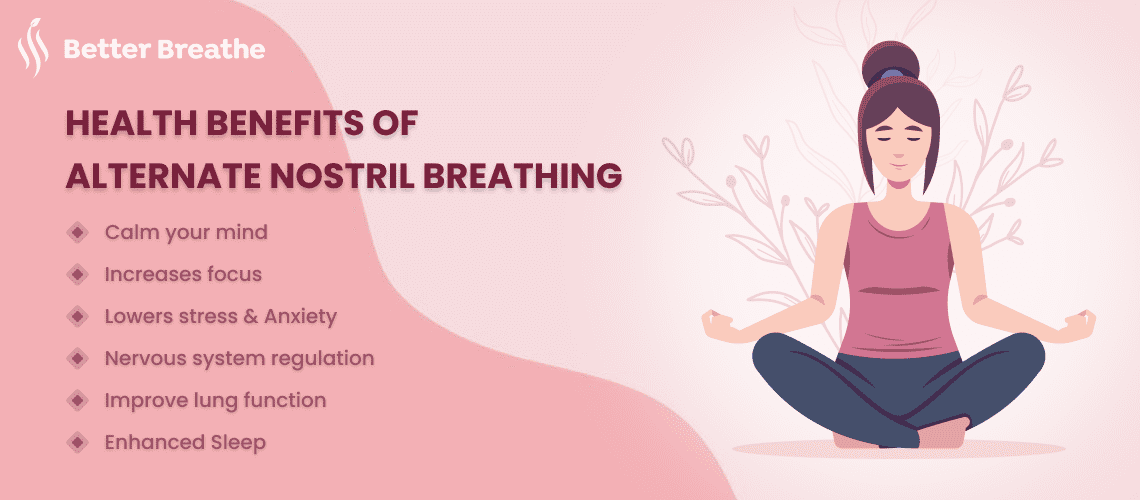Blog
Blog Details
The Alternate Nostril Breathing Method for Focus & Mindfulness
Apr 08, 2024
4 min read

Alternate nostril breathing is an ancient yogic practice. In Sanskrit, this breathing technique is known as Shodhana Nadi Pranayam. It is also known as Anulom Vilom Pranayam, which means practicing cleaning the breathing channels. As we have learned in yoga teachings, there are many energy channels in our bodies called nadis. If we feel blockages in these channels, there might be health issues.
There are three main nadis called Pingla, Ida, and Sushumna which are believed to spiral around the spinal cord in a double helix shape.
They represent the two sides of a person’s personality - hot and cold, sun and moon, as well as active and passive.

In the Sanskrit language, what is the translation of Shodhana Nadi Pranayam/Anulom Vilom Pranayam? It means that you are about to use a subtle breathing technique to clear your energy. A few minutes of alternating nostril breathing can significantly lessen stress and fatigue.
It has been shown to have advantages for controlling the heart's autonomic function, which may reduce the risk of anxiety and cardiovascular disease.
A different emotional and sensuous power is exerted by each nostril over the mind and body. The left nostril, commonly referred to as Ida, is regarded as a more feminine channel. It is considered to have a cooling quality that is more nourishing on the inside and symbolic of the moon. You are more in tune with the five basic senses if you only breathe through your left nostril. The reason for this theory is that each sense, including taste, touch, smell, sight, and hearing, has an exceptional ability to focus on each other. This will make all of these senses more sensitive to each other. The person may experience a passive feeling and start to exhibit depressive symptoms when the left nostril becomes overly dominant.
The Pingala, located in the right nostril, connects to the masculine presence. It is said to have a connection to the sun. Yet the Pingala can become overly forceful, agitated, and unfocused if it exerts too much control. These feelings are typically linked to movement and manipulation. Together, they may have a detrimental effect on a person's mood.
This breathing technique will increase breath retention with each inhalation and exhalation. This is the most widely practiced breathing technique because it has such a strong impact after only a short period of practice. The four-sided layout of the exercise is named Box Breathing. You can do it wherever and whenever you need to be more engaged in really demanding work. It can be practiced as part of your daily routine before working out, in traffic, while waiting in lines, and wherever else you can. It slows down breathing and deepens attention abilities in addition to developing stronger breathing muscles. Even after five minutes of Box Breathing, your body is profoundly relaxed and your mind is alert and concentrated.
Ida and Pingala swing like a pendulum. The other deteriorates as one gains strength. Our everyday activities and interactions impact how our emotions fluctuate. The pendulum's position in the center of Ida and Pingala allows focus and emotional balance.
Alternative nostril breathing is an excellent method to practice before meditating as it calms the mind and prepares it for meditation. As per research, it is preferred to practice this technique for 10 minutes every day.

Most people can safely practice alternate nostril breathing. If you have a lung ailment like asthma or COPD, it may be difficult for you to take deep breaths. However, simple exercises like these can improve breathing. Practice in a leisurely manner. Keep your inhalers close by if you use them.
Alternate-nostril breathing may usually be practiced comfortably at home. Consult your physician or a respiratory therapist before doing this exercise if you have a medical issue. It may also be beneficial to learn the proper breathing method from a certified yoga instructor. You can likewise download our app Better Breathe available on the Play Store and App Store and follow the instructions for the exercise. Furthermore, this app will help you find various other breathing techniques to help you in your day-to-day life.